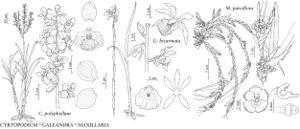Difference between revisions of "Maxillaria parviflora"
Bot. Mus. Leafl. 21: 258. 1967.
FNA>Volume Importer |
FNA>Volume Importer |
||
| Line 14: | Line 14: | ||
|name=Maxillaria conferta | |name=Maxillaria conferta | ||
|authority=(Grisebach) C. Schweinfurth ex León | |authority=(Grisebach) C. Schweinfurth ex León | ||
| − | }}{{Treatment/ID/Synonym | + | }} {{Treatment/ID/Synonym |
|name=Ornithidium confertum | |name=Ornithidium confertum | ||
|authority=Grisebach | |authority=Grisebach | ||
| Line 32: | Line 32: | ||
|elevation=0–10[–1200] m | |elevation=0–10[–1200] m | ||
|distribution=Fla.;Mexico;West Indies;Central America (to Honduras);South America. Maxillaria parviflora flowers in September in Fla. and in November in Central America. | |distribution=Fla.;Mexico;West Indies;Central America (to Honduras);South America. Maxillaria parviflora flowers in September in Fla. and in November in Central America. | ||
| − | |discussion=<p>Maxillaria parviflora flowers in September in Florida and in November in Central America.</p><!-- | + | |discussion=<p><i>Maxillaria parviflora</i> flowers in September in Florida and in November in Central America.</p><!-- |
--><p>The Florida occurrence is based on a collection by Roger Hammer from a single host tree; other unconfirmed sightings have been made. The several large plants reported by Hammer, the occurrence in Cuba, and the presence of other widespread tropical species locally leaves little doubt of the identity and presence of this outlier in the flora.</p><!-- | --><p>The Florida occurrence is based on a collection by Roger Hammer from a single host tree; other unconfirmed sightings have been made. The several large plants reported by Hammer, the occurrence in Cuba, and the presence of other widespread tropical species locally leaves little doubt of the identity and presence of this outlier in the flora.</p><!-- | ||
| − | --><p>The types of Scaphyglottis parviflora and Ornithidium confertum agree well with the Florida plant often recognized as Maxillaria conferta.</p> | + | --><p>The types of Scaphyglottis parviflora and Ornithidium confertum agree well with the Florida plant often recognized as <i>Maxillaria</i> conferta.</p> |
|tables= | |tables= | ||
|references= | |references= | ||
| Line 58: | Line 58: | ||
|publication year=1967 | |publication year=1967 | ||
|special status= | |special status= | ||
| − | |source xml=https://jpend@bitbucket.org/aafc-mbb/fna-data-curation.git/src/ | + | |source xml=https://jpend@bitbucket.org/aafc-mbb/fna-data-curation.git/src/8f726806613d60c220dc4493de13607dd3150896/coarse_grained_fna_xml/V26/V26_1325.xml |
|subfamily=Orchidaceae subfam. Epidendroideae | |subfamily=Orchidaceae subfam. Epidendroideae | ||
|tribe=Orchidaceae tribe Maxillarieae | |tribe=Orchidaceae tribe Maxillarieae | ||
Revision as of 16:42, 18 September 2019
Plants epiphytic, climbing. Stems with pseudobulbs distributed 2–8 cm along conspicuous rhizome; pseudobulbs nearly cylindric to ovoid, 1.5–3 cm. Leaves 1 per shoot; blade lanceolate, 9–20 × 0.9–2 cm, almost leathery, apex acute. Inflorescences several, at base of mature shoots, less than 1 cm. Flowers white to light yellow [purplish in Jamaican populations] with yellow-orange lip; sepals ovate, 6–7 × 3–3.5 mm, leathery, apex acute; lateral sepals 1/3 connate; petals ovate-elliptic, 4.5–5 × 2–2.5 mm, apex keeled, acute; lip continuous with column foot, deltate to 3-lobate, 2.5–4 × 3 mm when spread, lateral lobes somewhat erect; callus a simple transverse ridge connecting lateral lobes; column cylindric, stout, less than 2.5 mm, foot less than 1 mm. Capsules 7–8 mm.
Phenology: Flowering fall.
Habitat: Epiphytic on Fraxinus caroliniana (pop-ash)
Elevation: 0–10[–1200] m
Distribution

Fla., Mexico, West Indies, Central America (to Honduras), South America. Maxillaria parviflora flowers in September in Fla. and in November in Central America.
Discussion
Maxillaria parviflora flowers in September in Florida and in November in Central America.
The Florida occurrence is based on a collection by Roger Hammer from a single host tree; other unconfirmed sightings have been made. The several large plants reported by Hammer, the occurrence in Cuba, and the presence of other widespread tropical species locally leaves little doubt of the identity and presence of this outlier in the flora.
The types of Scaphyglottis parviflora and Ornithidium confertum agree well with the Florida plant often recognized as Maxillaria conferta.
Selected References
None.
